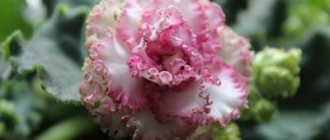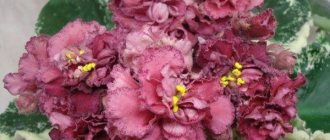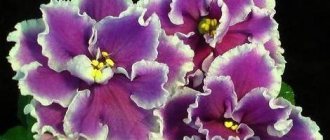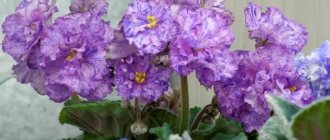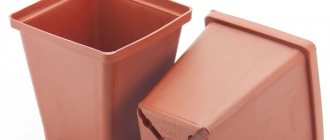The flowering of violets is greatly influenced by the conditions in which the plant is grown . This especially affects young specimens.
Low or high temperatures, chemicals or age of seeds can give rise to mutations that can allow you to grow a new beautiful variety or turn a flower into a “gray mouse”. When choosing varietal Saintpaulias for your home collection, sometimes from the seller you can hear such a definition as sport violets: we will explain what this means and how they differ from varietal plants later in our article.
Inheritance of varietal characteristics by violets
All modern varieties of violets are the result of various mutations in the DNA chain of plants. Violets began to be grown at home in 1893. And only by 1959 the first varieties of variegated violets were grown. This became possible when breeders learned to influence plant mutation, rather than wait for it to spontaneously manifest.
Thanks to selection, variegated varieties of violets have emerged.
A mutation is a damage or change in the genetic code or chromosomal chain . It occurs under the influence of:
- ionizing radiation;
- threshold, high or low, temperatures;
- mechanical influences;
- ultrasound;
- chemical substances.
Violets are very susceptible to variability. She may be:
- Modification. It is not inherited. Occurs when growing conditions change: temperature, light, soil salinity. It is easy for a plant to return to its original properties if optimal conditions are created for it;
- Mutational. Passed on by inheritance. It is impossible to return to the original form.
It is thanks to the susceptibility of violets to mutations that a large number of varieties with a wide variety of shapes and colors of leaf blades, flower sizes and colors have been bred.
The transmission of varietal characteristics by inheritance in different types of Saintpaulia occurs in different ways.
Important! Depending on which variety of violet was propagated in what way, the degree of inheritance of varietal characteristics by the young rosette is determined.
Saintpaulias are propagated by:
- seeds;
- stepchildren;
- cuttings;
- leaf plates or their fragments;
- peduncles;
- use meristem reproduction.
The most complete correspondence to the mother plant is obtained by reproduction using stepsons, peduncles and the meristem method. These methods are used for breeding chimera violets or fancy Saintpaulias.
Stepchildren retain varietal characteristics well.
Violets with solid colors or borders can inherit varietal characteristics when propagated from cuttings or leaves. It should be borne in mind that the border does not always appear during the first flowering, so it is recommended to wait until it blooms again.
Features of care
Saintpaulias of trailer forms, in terms of the conditions for keeping them indoors, are not much different from ordinary varieties of violets: they are not too demanding in the process of care, they only sometimes show their character, they do not like transplants, but they definitely need to form a decorative outline.
You just need to study their life attitudes and follow the advice of experienced flower growers to get decorative bushes.
Content Rules
The main conditions for the comfortable growth of any plant are:
- correct placement of the specimen in the room;
- creating the necessary light regime;
- maintaining temperature indicators at the required level.
In terms of lighting, violet trailers have some requirements. Due to the constant formation of buds, they need long daylight hours (ideally half the day) without prolonged exposure to direct rays of the sun.
These conditions can be met by placing the pots on the windowsills on the east or west side and creating additional lighting with fluorescent spectrum lamps in cold seasons.
Flowering for a long time in trailer forms of violets is impossible without slight differences in temperature at different times of the day and night.
The optimal temperature characteristics for them will be +20 + 24°C during the day and about two degrees less at night. It should be noted that the age of the trailer violet affects its temperature preferences: young specimens are more demanding of heat than adult plants.
CAREFULLY! All varieties of trailer Saintpaulias cultivated at home are especially afraid of drafts and sudden temperature changes. Therefore, ventilation of premises should be carried out under close monitoring of air flow movements in dangerous proximity to violets
And under no circumstances should they be allowed to be exposed to direct blows.
Watering requirements
Compliance with the irrigation regime involves regular watering without overflowing or drying out the soil at any time of the year. The amount and frequency of watering depends on the room temperature, air dryness, the size of the flowerpot and the trailer plant itself. It is optimal to water once every 7 days, but for mini and microminiature groups - a little more often due to their small size.
Microminiature varieties are watered more often than standard varieties.
For a trailer violet, it is necessary to create a good drainage system in the vessel. You should also drain excess water from the pan to prevent root rot.
Top dressing
Trailer varieties of violets are in a blooming state for most of the year, so for sufficient nutrition they need regular, but not frequent feeding.
Fertilizers should be applied once a month after first watering the plant. The dose indicated on the package should be reduced several times. It is possible to alternate feeding with organic and mineral fertilizers.
It is forbidden to feed recently planted or transplanted specimens (the standby period is about 2 months) - there is a danger of chemical burns to the plant from an overdose of fertilizer.
It is not recommended to feed young plants until they are two years old.
Transfer
It is permissible to replant fast-growing young specimens twice a year, provided they grow out of an old flowerpot. With each subsequent transplant, the pot is taken to be slightly larger in diameter, but its depth does not need to be increased.
As the violet-trailer grows up, it begins to have an increasingly negative attitude towards interference in its life rhythms. Therefore, transplants are reduced to once every 3 years, carried out using the transshipment method. Gradually you can move on to partial replacement of the top layer of the substrate.
Adult trailer violets do not like frequent transplants.
ADVICE! To enhance the decorative effect that trailers of hanging violets have, you should choose flowerpots with high stems or hanging vessels. This will make it more convenient for the plant to form its contour.
After transshipment and slight compaction of the substrate, you need to remove old, damaged and non-standard leaves to allow the trailer violet to quickly grow more children and form a lush green mass.
What does violet-sport mean?
What is the sport of violets? This is a plant that has lost the varietal characteristics of its parent. That is, mutations occurred in the DNA structure that led to the appearance of a completely different Saintpaulia.
In such a situation, you can see varietal flowers and flowers of a different color or shape on the blooming rosette. Such Saintpaulias will never be able to regain the characteristics of their variety.
Flowers of different colors on one plant.
In vegetative propagation, the daughter flower is a genetic clone of the mother plant. However, sometimes varietal characteristics are not transmitted due to somatic mutations. Then you get Saintpaulia “sport”.
Mutations can change:
- colors of inflorescences;
- remove or add terry;
- shape and color of leaf blades;
- flower and leaf size.
Sporting most often returns Saintpaulia to its original form, that is, makes it less original. Degeneration into sports is considered an undesirable phenomenon. Sometimes sports are born that mark the beginning of new, even more beautiful than the parent varieties. You can see examples below.
Lyon`s Spectacular – Lyon`s Spectacular Blue.
Emerald Love – Emerald City.
Winter Parasol – Iceberg.
Ruffled Skies – Ruffled Skies II.
The first variegated violets are also nothing more than sports.
Breeders disagree: some believe that the emerging sport must be ruthlessly destroyed along with the mother rosette in order to maintain the purity of the variety. Others register such violets, continuing their propagation as a new variety.
obtained in this way may be unstable in its mutations. Subsequent generations of rosettes may flourish like the parent Saintpaulia, but there is a high probability of subsequent mutation.
However, a large number of magnificent and varied varieties of violets are nothing more than sports from an ordinary flower, obtained as a result of DNA changes.
History of creation, decoding of the abbreviation “LE”
It was bred in Ukraine by the famous breeder E. Lebetskaya.
All varieties have the prefix LE in their name.
A distinctive feature of the Saintpaulias grown by Elena is the presence of an even, symmetrical rosette.
This variety of violet looks impressive thanks to its rose-like flowers.
Breeding Basics
Breeders, developing new varieties of violets by pollinating one flower with another, take into account the dominant and recessive characteristics of the parent plants.
This makes it possible to predict what characteristics planting material obtained by seed propagation will have.
Dominant and recessive genes must be taken into account when vegetatively breeding violets.
In the process of evolution, planting material has undergone multiple crossings, that is, a dominant gene can appear and then the violet goes into sporting:
- change in inflorescence color;
- terryness appears or goes away;
- the shape of the leaf plate changes;
- variegation appears or disappears;
- the size of flowers and leaves changes.
The mutations are subsequently inherited by the next generation. There are factors that increase the percentage of mutations:
- when propagating Saintpaulia by leaves or cuttings, when a young rosette is born from an undifferentiated mass of cells - callus;
Callus on a violet cutting.
- conditions for keeping the queen cell;
- germination of children: extreme temperatures, radiation from fluorescent lamps;
- treatment with hormones and growth stimulants;
- change in soil pH.
Violets can be divided into four groups according to the preservation of varietal characteristics that appear during vegetative propagation:
- stable hybrid , grown rosettes do not differ from each other;
- a resistant mutant or sport grown from an unstable hybrid;
- fancy Saintpaulias, which are unstable hybrids;
- chimera violets are a very unstable hybrid.
Chimeras have the most unstable varietal characteristics.
Meristem cells carrying mutated genes are located in the upper part of the plant, therefore, when breeding chimeras and fantasy violets these characteristics can be preserved in a young rosette using only the upper part of the stem - the peduncle or stepsons with a chimera or fantasy bud.
Attention! Breeding chimeras and fantasy varieties from a peduncle or stepson does not provide a 100% guarantee of repetition of the variety.
With microclonal propagation , when the beginning of a new rosette is a piece of tissue with altered genes, significantly fewer sports appear. This method of reproduction is available only in special laboratories .
The question arises: is it possible to breed sporting violets? If Saintpaulia has degenerated from a princess into a “gray mouse,” then repeating such a plant makes no sense. When Saintpaulia has mutated into an even more original flower, its further breeding does not always give a 100% positive result.
The plant may show different blooms each time. However, some sports have been registered as new varieties.
Methods of reproduction, rules of transplantation and rejuvenation
The variety can be propagated by shoots or leaves.
In the first case, the stepsons are carefully separated from the mother's outlet and planted in loose soil (50 ml glass). It is recommended to place it in a greenhouse. Under the right conditions, within a couple of weeks the daughter plant will take root.
Leaves can be rooted both in water and in the ground:
- in the first case, you should use a dark container (medicine bottle) and boiled water. You can add a drop of hydrogen peroxide or a tablet of activated carbon to prevent the stem from rotting. As soon as the leaf has given roots, it is planted in the ground and wait for the babies to appear;
- for more advanced gardeners, you can use the method of rooting leaves in the ground: a leaf is placed in plastic glasses with light soil (cut of the stem at 45 degrees) and lightly sprinkled with earth;
- It is optimal to use a bag or greenhouse for rooting. In the first days, the leaf may lose turgor, this is not scary;
- The soil needs to be moistened immediately after planting, then you can water it drop by drop if it dries out.
Once every six months or after flowering, you need to transplant the rosette into fresh soil. The old substrate is quickly depleted, which harms the plant.
After flowering, the violet should be replanted.
If the rosette has grown a lot, transplant it from the cup to pot 8 or 9:
- We put drainage (expanded clay) on the bottom;
- Pour some earth (see composition above);
- Carefully place the plant;
- Sprinkle with earth and tamp down a little.
It takes about 10 months from the leaf to the blooming young rosette. The first flowering is most often not too abundant, the subsequent ones already produce caps of flowers.
IMPORTANT! You should not bury the violet to prevent the growing point from rotting!
What determines the color of flowers
In addition to frequent sports activities, it is capable of darkening the flower. Your pale pink pet may turn deep pink or even red.
There are several reasons:
- Age.
- Temperature change. The increase affects the color change of the petals. The decrease affects the increase in the green ruffle of the leaf.
- Increasing soil acidity.
The ancestors of modern violets were predominantly purple in color. Therefore, when color changes under the influence of temperatures or when going to sports, the flowers darken.
How to grow a violet from a leaf? Features of caring for Saintpaulia “Royal Lace” and “Ice Rose”.
